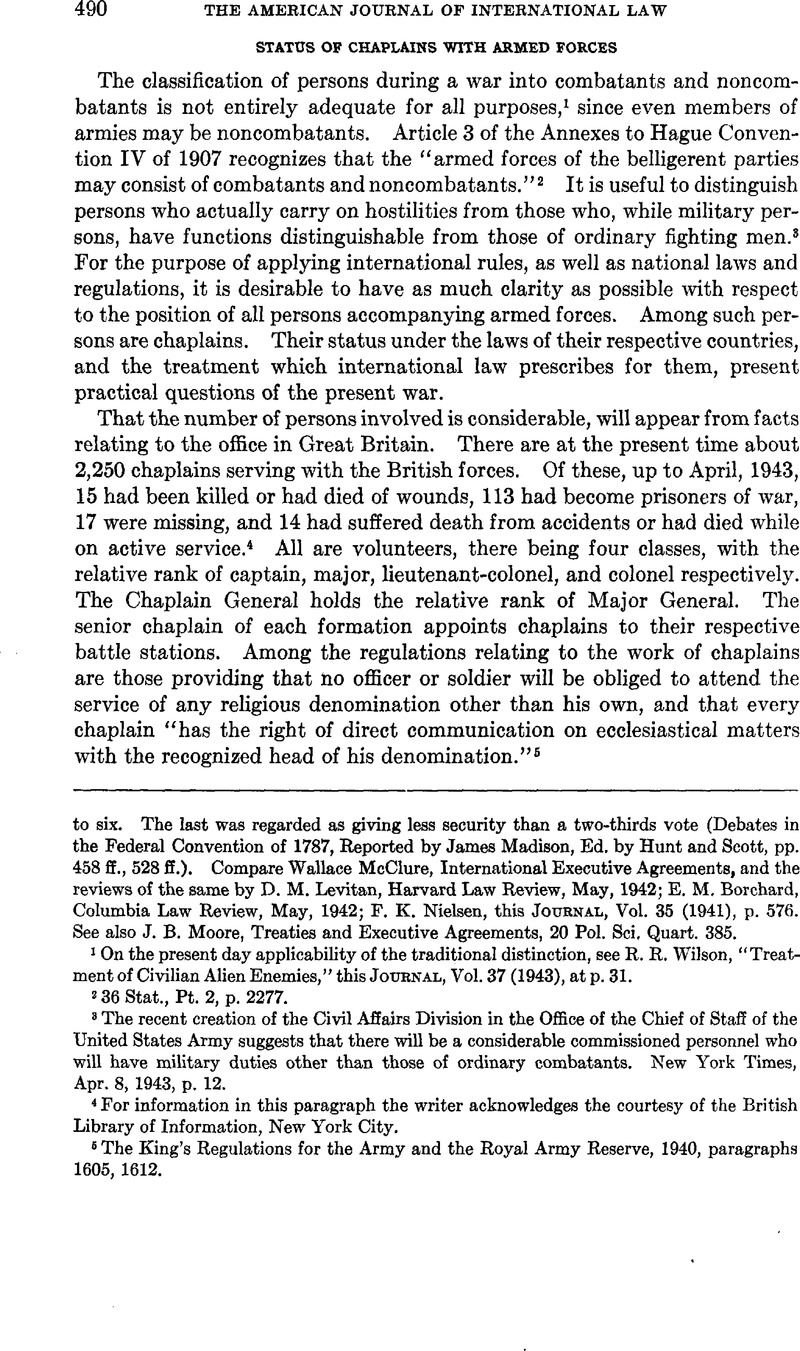Article contents
Status of Chaplains with Armed Forces
Published online by Cambridge University Press: 12 April 2017
Abstract

- Type
- Editorial Comment
- Information
- Copyright
- Copyright © by the American Society of International Law 1943
References
1 On the present day applicability of the traditional distinction, see Wilson, R. R., “Treatment of Civilian Alien Enemies,” This Journal, Vol. 37 (1943), at p. 31 Google Scholar.
2 36 Stat., Pt. 2, p. 2277.
3 The recent creation of the Civil Affairs Division in the Office of the Chief of Staff of the United States Army suggests that there will be a considerable commissioned personnel who will have military duties other than those of ordinary combatants. New York Times, Apr. 8, 1943, p. 12.
4 For information in this paragraph the writer acknowledges the courtesy of the British Library of Information, New York City.
5 The King’s Regulations for the Army and the Royal Army Reserve, 1940, paragraphs 1605, 1612.
6 Press release from the Office of the Chief of Chaplains, Dec. 15, 1942.
7 1 Stat., 222, 223. The appointee was to be entitled to fifty dollars per month, “including pay, rations and forage.”
8 Act of July 22, 1861, 12 Stat., 270. Each chaplain (appointed by the regimental commander on the vote of the field officers and company commanders on duty with the regiment) was to receive the pay and allowances of a captain of cavalry.
9 12 Stat., 404.
10 Acts of Oct. 6, 1917, and May 25, 1918, 40 Stat., Pt. 1, pp. 394, 561.
11 Press release mentioned in note 6, supra.
12 Army Regulations, 605–30b. The present comment has been restricted to Army regulations and, because of lack of space, has not included such matters as the recently announced plan of the Navy for training chaplains in designated educational institutions.
13 Act of Nov. 21, 1941, 55 Stat., 779; Army Regulations, 605–40, para. 5.
14 Army Regulations, 350–1500. See note 12, supra.
15 In a recent statement the Chief of Chaplains emphasized that the Army “in its policy concerning religion, exemplifies the spirit of freedom of conscience which is one of the ideals for which our troops are fighting.” (Press release, War Dept., Bureau of Public Relations, March 20, 1943.)
16 Army Regulations, 260–10, para. 7.
17 World Alliance News Letter, Vol. XIX, No. 5 (May, 1943), p. 7.
18 An inquiry did not reveal that any such Japanese persons have as yet been captured by American forces.
19 W. E. Hall, Int. Law (7th ed., 1917), p. 427.
20 Gen. Orders No. 46 of the Confederate Army, and No. 90 of the Union Army, Official Records of the Union and Confederate Armies, Ser. II, Vol. IV, pp. 269, 288.
21 Italics inserted.
22 22 Stat., 940. By the same article, when individuals thus allowed to continue in their duties in occupied territory should “cease from their functions,” they were to be “delivered by the occupying army, to the outposts of the enemy.” Additional Article I would have allowed some leeway to belligerents in the matter of allowing withdrawal of such persons, due to military necessities. A. Pearce Higgins, The Hague Peace Conferences (1909), p. 14.
23 35 Stat., Pt. 2,1885. By Art. 13, they were to receive, while in the enemy’s hands, the same allowance and pay as that granted to persons holding the same rank in the enemy’s army.
24 47 Stat., Pt. 2, 2074. The principal belligerents in the current war are parties, all except Russia having ratified as signatories, and the Soviet Union having acceded on Sept. 26, 1931.
25 Oppenheim, Int. Law (6th ed.) II (1940), p. 203.
26 Statement from the British Library of Information, New York City. The Secretary of State for War said on Dec. 1, 1942, that chaplains who were prisoners in Germany and Italy were usually allowed to exercise their ministry in camps. He said that there was very little information concerning those in Japan, but that there was some evidence that services were held in camps where chaplains who had been captured at Hong Kong were interned. Pari. Deb., New Ser., Vol. 385, Commons, c. 1037–1038.
For a statement by a newspaper correspondent concerning the treatment of certain British chaplains, see Harold Denny, Behind Both Lines (1942), pp. 150–151, 157.
27 47 Stat., Pt. 2, 2021.
28 U. S. Dept. of State Bulletin, May 29, 1943, p. 472: “Negotiations are . . . under way for the return and release of such captured sanitary and religious personnel as may not be needed to care for their compatriots who are prisoners of war.” Cf., however, note 18, supra.
- 3
- Cited by


